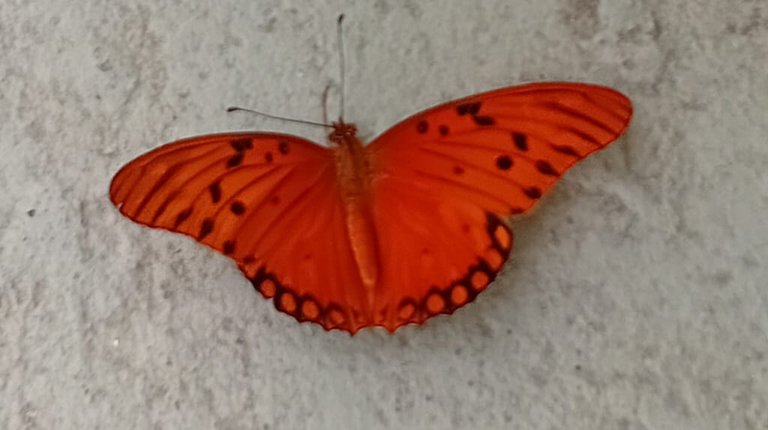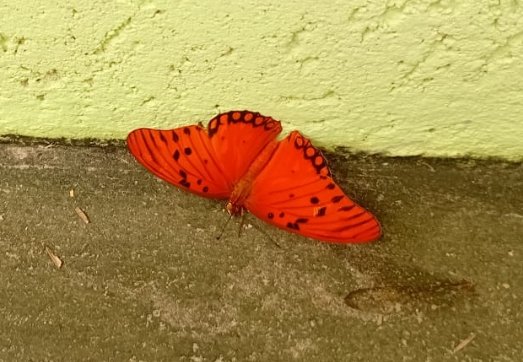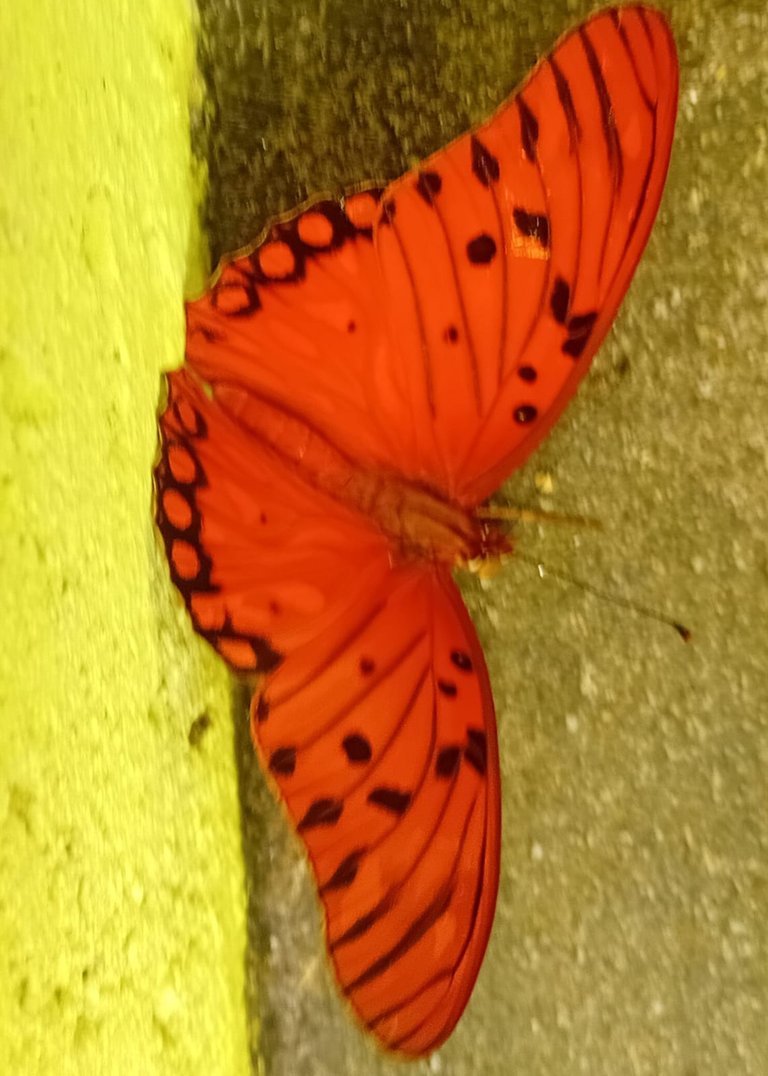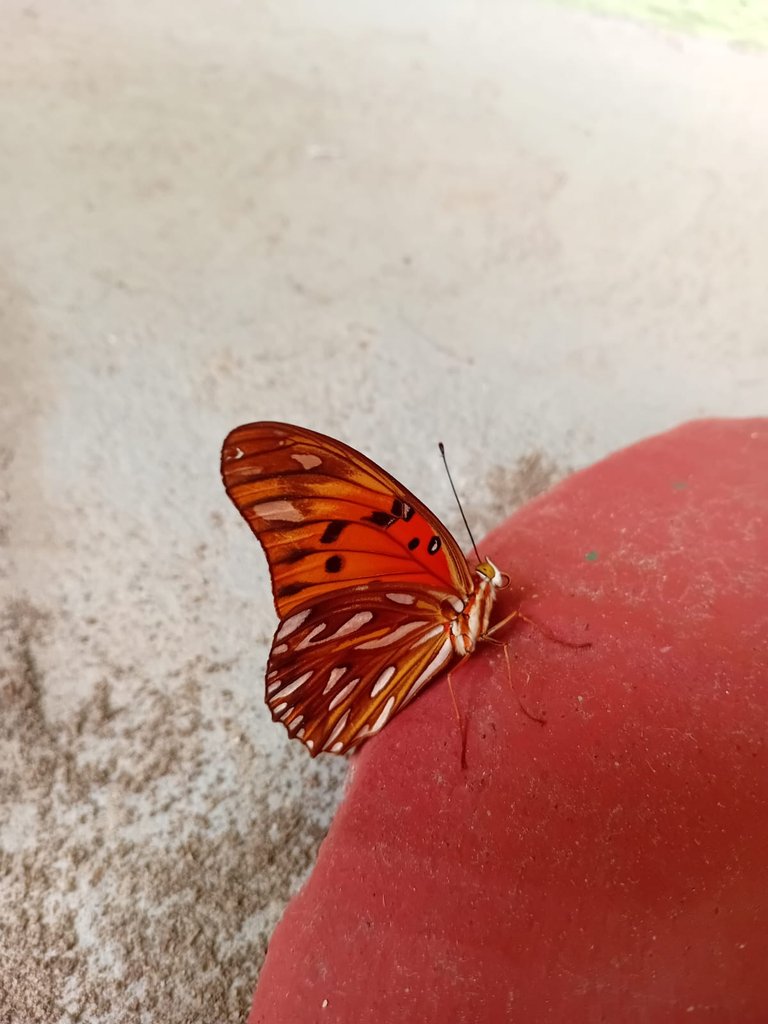Un abrazo para todos en esta comunidad de #Holos-Lotus.
Hace varios días que no pasaba por aquí y realmente extrañaba compartir con ustedes al menos una breve parte de las cosas que veo, descubro, saboreo y hago en un país completamente distinto al mío en cultura culinaria, paisajes, flora y fauna.
En esta ocasión les quiero presentar a una criatura hermosa, tan bella que no pude resistirme a fotografiarla y posteriormente hacer este post sobre ella.

Mi hermana, conocedora de mi manía y amor desenfadado por casi todos los animalitos, fue quien me avisó que había encontrado, justo a la puerta del edificio donde vivimos, una mariposa.
No perdí tiempo, corrí hacia la entrada y me encontré a la mariposa más hermosa que había visto en muchísimo tiempo, con un color naranja muy fuerte, tanto que las fotos no logran captar toda la intensidad. No se movía, estaba muy quieta, tan quieta que supusimos que estaba muerta.

Al principio pensamos que era una mariposa monarca, por su color anaranjado por las manchas blancas y las líneas negras, además de que, aquí en Guyana se encuentran en muchos lugares, sobre todo en áreas boscosas. Pero descartamos esa posibilidad porque nuestra visitante no tenía el cuerpo oscuro, característica que prevalece en las mariposas monarcas adultas.
Era peligroso que se quedara allí en el piso, justo a la entrada, donde cualquier inquilino podía lastimarla. Así que, ayudándonos de unas hojas finas pero firmes, logramos levantarla con suma delicadeza y depositarla entre los arbustos que rodean la fachada del edificio.


Varios minutos observamos su descanso, hasta que, de repente, voló de flor en flor, como si nada le hubiese acontecido. Nos quedamos admirando su vuelo naranja hasta que, un poco más allá, volvió a descansar entre las hojas de una pequeña mata.
Curiosa por saber su “nombre”, corrí a investigar sobre el tema en sitios oficiales de Lepidopterología, para intentar comparar las características de nuestra amiga, con otras mariposas. Y créanme cuando les digo que fueron muchas las especies que se le parecían, entre ellas las Virrey, pero estas, al igual que las Monarcas, en su mayoría tienen el cuerpo oscuro.
No me di por vencida, hasta que encontré una, perfectamente igual a “mi mariposa” y se trata de la “Mariposa de los espejos” o “Mariposa espejitos”.
Esta mariposa es de color anaranjado manchas y rayas negras y blancas, con figuras en forma de círculos en los márgenes de sus alas. El cuerpo es de un color entre amarillo y carmelita claro y por debajo es muy blanco, tanto que llega a producir reflejos metálicos cuando recibe la luz del sol, motivo por el cual recibe su nombre de “Espejito”.
Investigando, también supe que esta belleza se alimenta del néctar de las flores, su vuelo es muy rápido y ágil sobre todo temprano en la mañana y es fácil encontrarla en los parques o arbustos de la ciudad.
Aunque creo firmemente que mi mariposa pertenece a la familia de las Mariposas Espejos, siempre tendré la duda de si estaré o no en lo cierto.
¿Qué dices? ¿Me ayudas a investigar y a salir de la duda?
Pero ten cuidado mientras investigas, pues podrías caer rendido de amor ante uno de los diseños y colores más hermosos de la naturaleza.


A hug to everyone in this #Holos-Lotus community.
I haven't been here for several days and I really missed sharing with you at least a brief part of the things I see, discover, taste and do in a country completely different from my own in terms of culinary culture, landscapes, flora and fauna.
On this occasion I want to introduce you to a beautiful creature, so beautiful that I couldn't resist photographing it and later making this post about it.

My sister, aware of my mania and carefree love for almost all animals, was the one who told me that she had found, right at the door of the building where we live, an orange butterfly. I didn't waste time and ran towards the entrance and found the most beautiful butterfly I had seen in a long time with a very strong orange color, that the photos fail to capture all the intensity. It was not moving, it was very still, so still that we assumed it was dead.

At first we thought it was a monarch butterfly, because of its orange color with white spots and black lines, plus, here in Guyana they are found in many places, especially in forested areas. But we ruled out that possibility because our visitor did not have a dark body, a characteristic that prevails in adult monarch butterflies.
It was dangerous for her to stay there in the apartment, right at the entrance, where any tenant could hurt her. So, with the help of some thin but firm leaves, we managed to lift it very delicately and place it among the bushes that surround the façade of the building. We watched him rest for several minutes, until suddenly he flew from flower to flower, as if nothing had happened to him. We stayed a little longer admiring its orange flight until, a little further on, it returned to rest among the leaves of a small bush.
Curious to know her “name”, I ran to research the subject on official Lepidopterology sites, to try to compare the characteristics of our friend with other butterflies. And believe me when I tell you that there were many species that resembled it, among them the Viceroy, but these, like the Monarchs, mostly have dark bodies.
I didn't give up until I found one, so perfectly like “my butterfly” and it was the “Mirror Butterfly” or “Mirror Butterfly”.
This butterfly has orange spots and black and white stripes, with circle-shaped figures on the margins of its wings. The body is a color between yellow and light brown and underneath it is very white, so much so that it produces metallic reflections when it receives sunlight, which is why it receives its name “Mirror”.
While researching, I also learned that this beauty feeds on the nectar of flowers, its flight is very fast and agile, especially early in the morning, and it is easy to find it in parks or bushes in the city.
Although I firmly believe that my butterfly belongs to the Mirror Butterfly family, I will always doubt whether or not I am right.
¿What are you saying? ¿Can you help me investigate and clear up the doubt?
But be careful while you investigate, as you could fall in love with one of the most beautiful designs and colors in nature.

